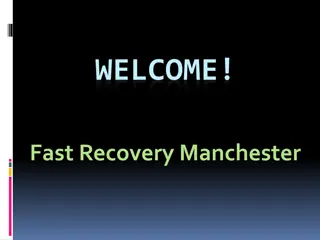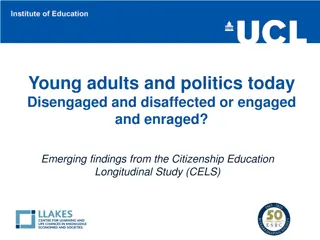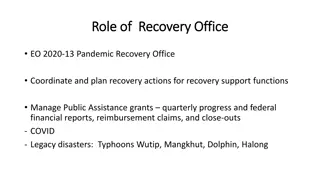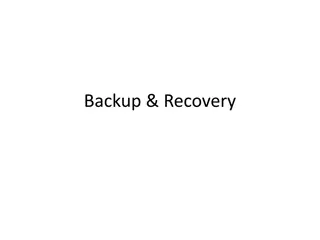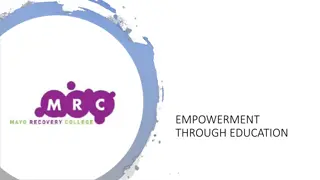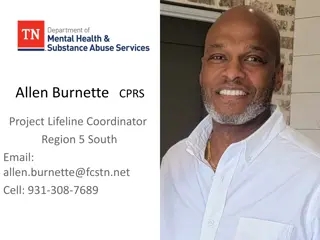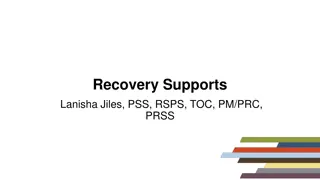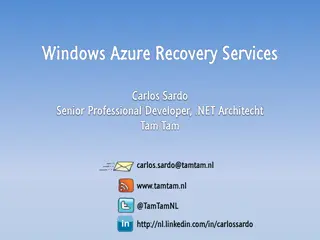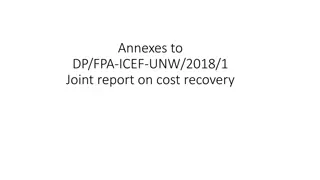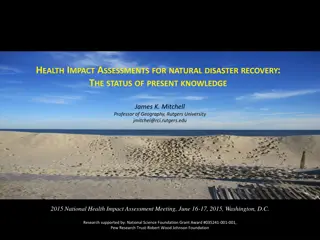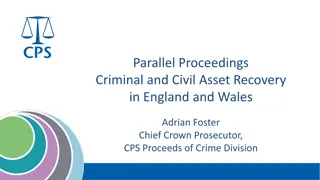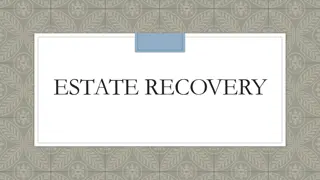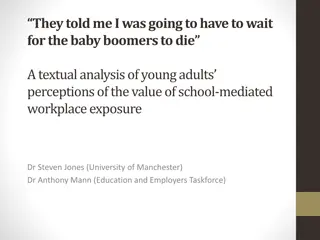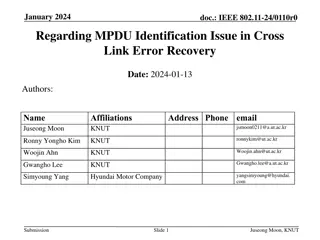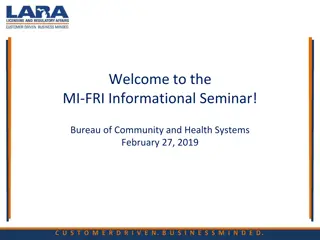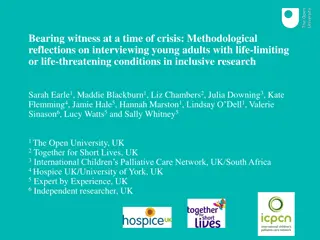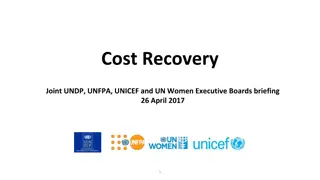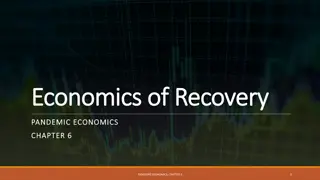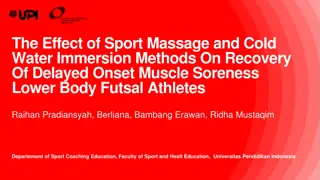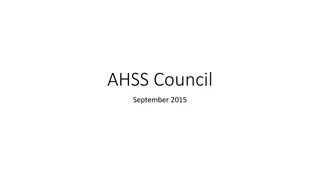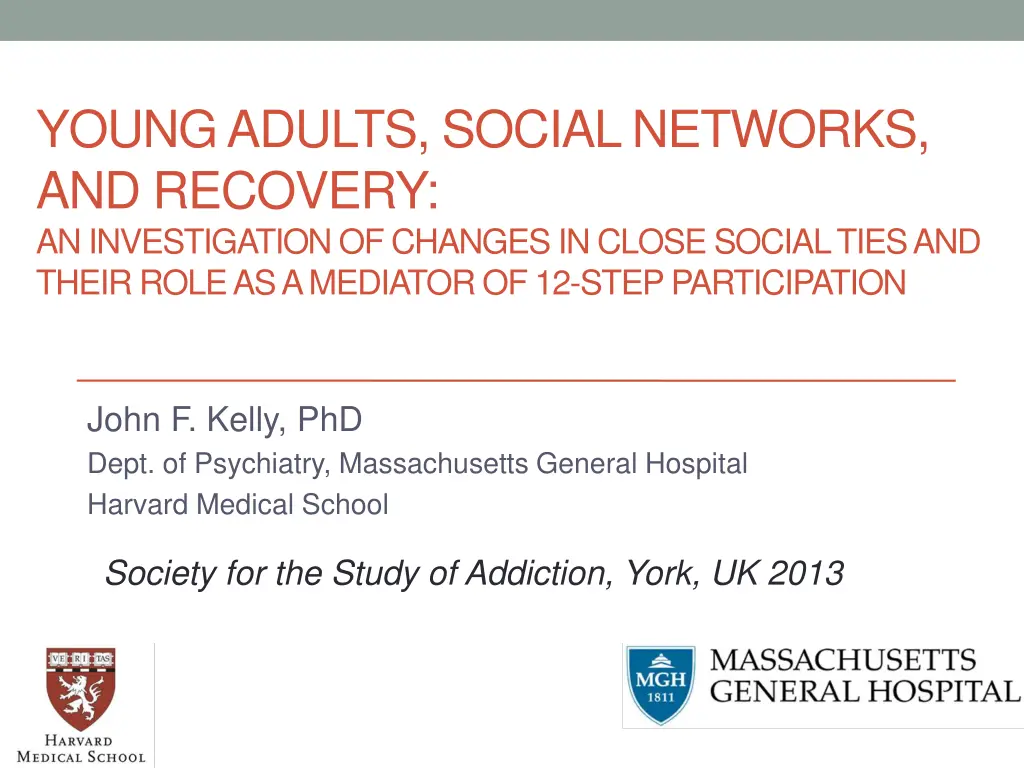
Social Networks and Recovery from Substance Use Disorders
This study explores the role of social networks in supporting recovery from substance use disorders, particularly through mechanisms like participation in 12-step programs. It investigates the impact of social factors on alcohol use behaviors, the importance of Mutual-help Organizations like AA, and how different individuals may benefit from these support systems in various ways.
Download Presentation

Please find below an Image/Link to download the presentation.
The content on the website is provided AS IS for your information and personal use only. It may not be sold, licensed, or shared on other websites without obtaining consent from the author. If you encounter any issues during the download, it is possible that the publisher has removed the file from their server.
You are allowed to download the files provided on this website for personal or commercial use, subject to the condition that they are used lawfully. All files are the property of their respective owners.
The content on the website is provided AS IS for your information and personal use only. It may not be sold, licensed, or shared on other websites without obtaining consent from the author.
E N D
Presentation Transcript
YOUNG ADULTS, SOCIAL NETWORKS, AND RECOVERY: AN INVESTIGATION OF CHANGES IN CLOSE SOCIAL TIES AND THEIR ROLE AS A MEDIATOR OF 12-STEP PARTICIPATION John F. Kelly, PhD Dept. of Psychiatry, Massachusetts General Hospital Harvard Medical School Society for the Study of Addiction, York, UK 2013
The importance of social networks for recovery from substance use disorders (SUDs) Social forces can influence a variety of health behaviors, including alcohol and other drug use Successful recovery from SUD often involves changing social networks Supportive of abstinence & recovery Supportive of substance use
Social Network analyses Source: Rosenquist et al (2010). Annals Intern Med
12-step Mutual-help Organizations (MHO) one way to facilitate social network changes supportive of recovery AA most commonly sought source of help for alcohol problems in the US Number of Publications on AA and NA 1960-2010 Given public health significance, Institute of Medicine (IOM, 1990) called for AA research. 450 400 350 300 State of science summarized and further research opportunities outlined (McCrady and Miller, 1993) 250 200 150 100 Past 20 yrs significant increase in scientific interest and rigor focused on AA and its mechanisms 50 0 1960-70 1971-80 1981-90 1991-00 2001-10
How might MHOs like AA reduce relapse risk and aid the recovery process? Do these mechanisms differ for different people? Cue Induced RELAPSE Stress Induced Social Psych Drug Induced Bio- Neuro MHO 5 Source: Kelly and Yeterian (2013) , Mutual-help Organizations, In McCrady and Epstein Addictions: A Comprehensive Guidebook, Oxford Univ Press
Do more and less severely alcohol dependent individuals benefit from AA in the same or different ways? effect of AA on alcohol use for AC was explained by social factors but also by S/R and through negative affect (DDD only) Aftercare (DDD) Aftercare (PDA) Self-efficacy (NA) 5% Depression 3% Self-efficacy (NA) 20% SocNet: pro-drk. 16% SocNet: pro-drk. 24% SocNet: pro-abst. 11% Spirit/Relig 23% Depression 11% SocNet: pro- abst. 16% Self-efficacy (Soc) 21% Self-efficacy (Soc) 34% Spirit/Relig 21% Majority of effect of AA on alcohol use for OP was explained by social factors Outpatient (PDA) Outpatient (DDD) Self-efficacy (NA) 1% Depression 2% Self-efficacy (NA) 1% Depression 5% Spirit/Relig 6% Spirit/Relig 9% SocNet: pro-drk. 29% SocNet: pro-drk. 33% Self-efficacy (Soc) 27% Self-efficacy (Soc) 39% SocNet: pro- abst. 17% SocNet: pro- abst. 31% 6 Source: Kelly, Hoeppner, Stout, Pagano (2012) , Determining the relative importance of the mechanisms of behavior change within Alcoholics Anonymous: A multiple mediator analysis. Addiction 107(2):289-99
Figure 2. AA attendance and the percent change in both pro- abstinent and pro-drinking network ties from treatment intake to the 9-month follow-up in aftercare sample 7
Figure 2. AA attendance and the percent change in both pro- abstinent and pro-drinking network ties from treatment intake to the 9-month follow-up in outpatient sample 8
What about young adults? A Life Course Perspective A life course perspective: has the advantage of recognizing developmental stages and social contexts as risk or protective factors that facilitate or inhibit change that differ across the life span (Hser & Anglin, 2008). This transitional stage of human development confers high risk of substance use via peer influence, and waning but still influential parental influence. Implications for remission/recovery?
For young people seeking recovery from addiction: Depending on what age you begin recovery , sobriety conducive/supportive contexts will vary NSDUH Age Groups 100 Severity Category 90 No Alcohol or Drug Use 80 70 Light Alcohol Use Only 60 Any Infrequent Drug Use 50 40 Regular AOD Use 30 Abuse 20 10 Dependence 0 12-13 14-15 16-17 18-20 21-29 30-34 35-49 50-64 65+ NSDUH and Dennis & Scott
Given that for young adults sobriety conducive/supportive contexts may be at more of premium, MHOs may play a more important role Objectives 1. To describe the composition of and changes to substance use in the social networks of young adults post-treatment. 2. To examine whether changes in substance use in young adults social networks was associated with 12-step attendance and furthermore, if it mediated the relationship between 12-step attendance and abstinence.
Sample 302 young adults (20.4 1.6 years, range 18-24) undergoing residential 12-step-oriented treatment in the United States enrolled in observational study of treatment process and outcome. Mostly Caucasian (94.7%), male (73.8%) and single (100.0%); M LDQ =18.65 (8.7) Assessments completed at intake, discharge, and 3-, 6-, and 12-months post-discharge.
Measures Form 90 Percent days abstinent (PDA) from alcohol and other drugs and percent days heavy drinking (PDHD) Social Support Questionnaire (SSQ) Assessed up to 5 family members, friends, and others important people to whom they feel close; assessed their alc/drug use ( abstainer , infrequent user , regular user , possible abuser , abuser ) Stages of Change Readiness and Treatment Eagerness Scale (SOCRATES) Motivation to changes substance use Commitment to Sobriety Scale (CSS) Level of commitment to alcohol and drug abstinence Multidimensional Mutual-Help Activity Scale Mutual help attendance
Data Analysis Classified family (parents, siblings) & friends substance use as high-risk ( regular users , possible abuser/abusers ) vs. low-risk ( infrequent users or abstainers ). Hierarchical linear models (HLM) analyzed changes from baseline to month 12 in number of high- and low-risk persons within each relationship category. Test for mediation using cross-product of coefficients approach (MacKinnon et al, 2002) in a lagged, statistically controlled, model, to enhance causal inference (Kazdin and Nock, 2003).
Social network changes over time 3 During follow-up overall, average number of high-risk users decreased; average low- risk users increased in participants social networks (p<0.001). Number of Friends 2 1 0 Average number of high-risk friends, parents and other family members (excluding siblings) decreased (p<0.05), however there was no significant change in average number of high-risk siblings. 3 Number of Parents 2 1 0 3 Average number of low-risk friends and parents increased (p<0.05), however there was no significant change in average number of high-risk siblings or other family members (excluding parents). Number of Siblings 2 1 0 0 2 4 6 8 10 12 Time (months) Low-risk High-risk
Temporally Lagged Mediation Analyses: Tested model Number of High-Risk Friends (0m) Number of High-Risk Friends (6m) Number of Low- Risk Friends (0m) Number of Low-Risk Friends (6m) Baseline (0m) Covariates Alcohol/Drug Use Outcome (12m): Percent Days Abstinent (PDA) Percent Days Heavy Drinking (PDHD) 12-Step Attendance (3m) *All models controlling for predictors of attrition (education), baseline levels of PDA/PDHD, baseline levels of the mediator, and predictors of PDA/PDHD (age, gender, commitment to sobriety, motivation, prior hospitalization for alcohol/drug problems and meeting with other mutual help group members outside of meetings at baseline)
Mediation Analysis PDA PDHD Path B SE t p B SE t p Direct effect: 12-step attendance predicting PDA/PDHD 12-Step attendance PDA/PDHD 0.009 0.004 2.44 0.015 -0.002 0.001 -1.99 0.048 Mediational path: 12-step attendance predicting mediators 12-Step attendance Number of high-risk friends -0.003 0.003 -1.05 0.297 -0.003 0.003 -1.05 0.297 12-Step attendance Number of low-risk friends 0.006 0.004 1.58 0.116 0.006 0.004 1.58 0.116 Mediational path: mediators predicting PDA/PDHD Number of high-risk friends PDA/PDHD -0.344 0.080 -4.32 0.000 0.059 0.018 3.33 0.001 Number of low-risk friends PDA/PDHD 0.324 0.060 5.39 0.000 -0.064 0.013 -4.89 0.000 *All models controlling for predictors of attrition (education), baseline levels of PDA/PDHD, baseline levels of the mediator, and predictors of PDA/PDHD (age, gender, commitment to sobriety, motivation, prior hospitalization for alcohol/drug problems and meeting with other mutual help group members outside of meetings at baseline)
Mediation Analysis Social network change is not a mediator of the relationship between 12- step participation and substance use outcomes Sobel Test Statistic p-value Percent Days Abstinent High-Risk Friends Low-Risk Friends 0.974 1.445 0.330 0.148 Percent Days Heavy Drinking High-Risk Friends Low-Risk Friends -0.956 0.090 0.339 0.929
Mediation Analysis 12-step attendance (3m) significant predictor of subsequent (12m) PDA/PDHD in expected direction (p = .015 PDA and p = .048 PDHD). number of high-risk friends and low-risk friends strong predictors of outcome, in expected direction, with p-values of .001 or less. However, 12-step attendance was not found to significantly predict number of high/low-risk friends in this sample
Discussion and Conclusions Social changes important in SUD. One pathway to achieving recovery supportive social changes in adults has been via AA/NA. Treatment appears to have done a good job of helping young adults make recovery-beneficial changes in their social networks Both recovery-supportive social changes AND 12-step MHO participation predicted better outcomes, yet, findings highlight a potentially important developmental difference regarding ways that young adults benefit from 12-step participation While 12-step MHO participation promotes social network changes, MHOs may be less able to provide social network change directly for young adults, perhaps because similar-aged peers are less common (comprising only about 13% of MHO members). Findings highlight the importance of both social networks and 12-step MHOs, and raise further questions as to how young adults benefit from 12-step MHOs.

